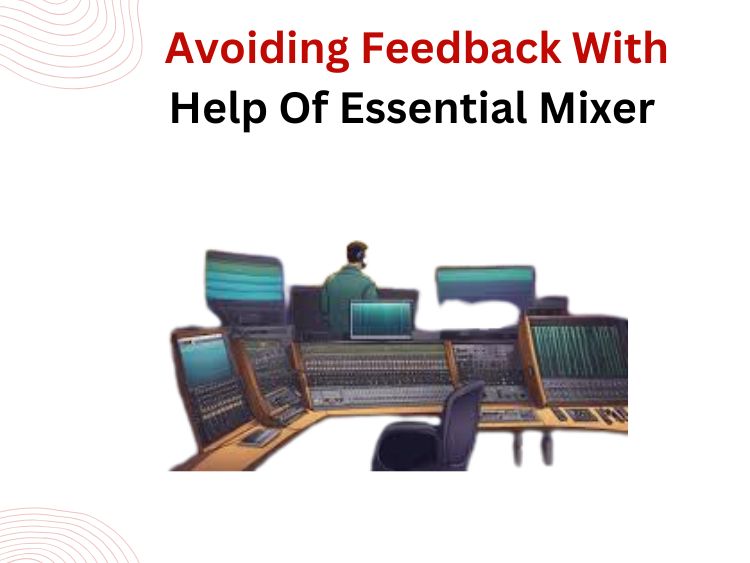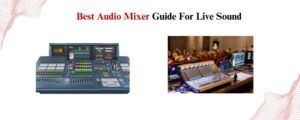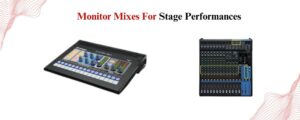Perhaps the worst thing to encounter during a performance is the sudden jarring screech of feedback. It can derail the energy of a set and affect even the most professional-sounding bands. A sound team’s responsibility, whether they’re mixing sound for a live corporate event or a small acoustic show, is to eliminate feedback at all costs.
The unfortunate news? Feedback and poor-quality audio can be avoided using the correct mixer techniques, placement strategy, appropriate ears, and a bit of finesse, unobtrusive feedback can be avoided, and utilize the audio live in its full glory. So, check this advanced guide aiming to ensure the users never experience feedback ever again.
Searching for a high-quality audio mixer? Buy 5 Core Audio DJ Mixer 20 Channel Sound Board Console 48V Phantom Power.
What Causes Feedback?
Before providing the recommended tips, understanding the concept of feedback is essential.
To put it simply, feedback is created when a mic picks up sound coming from the speaker and sends it back through the system. This produces a loop which escalates very quickly to a high-pitched squeal or low-end rumble, depending on the frequencies involved.
Common culprits:
- Microphones too close to speakers
- Too much gain causing sensitivity
- Poor choices of EQ filters
- Monitors not positioned correctly
Let’s address these issues one by one.
List of Top Mixer Tips for Live Sound
Everything Depends on Correct Gain Staging
“Gain staging” is an example of high-level strategizing and planning.
While setting up your mixer:
- Ensure all channel faders are at the bottom position first.
- Beg the performer to play or sing at volume.
- While monitoring the level meter, gradually increase gain (trim).
- Ensure you halt right before peak signal (healthy signal, no overload).
Excess gain can lead to amplified noise-enhancing and feedback risks. Many mixers, such as the 5 Core AMX 8FX, have added helpful features like LED meters, digital gain control, and even intuitive devices for maximum precision.
Remove Problem Frequencies Using EQ
Feedback will always occur at distinct frequencies. With graphic or parametric EQ, it is possible to find and reduce sound imbalances without removing quality.
This is how to do it:
- Make sure to do soundcheck. Slowly raise the gain until feedback becomes likely.
- Mark the corresponding region (e.g. 2.5 kHz or 800 Hz) and reduce it a notch on the EQ.
- Avoid boosting frequencies unnecessarily and focus on cutting instead.
Features for detecting feedback automatically during mixing, especially in digital models, are common with advanced mixers. These features pinpoint problem areas among certain bands and allow for precise changes.
Eyeing for simple steps to set up a mixer for a small gig? Read – Audio Mixer Setup for a Small Band Gig: The Complete Guide.
Microphone Technique and Placement
- The habits of the performer in regard to their microphone will be pivotal.
- You should always aim to use directional mics. This will block stage monitor signals.
- Tell the performers to face the microphone. Moving sideways and backwards means lowering the SNR.
- It is forbidden to aim microphones towards loudspeakers.
Monitor Mixes Matter More Than You Think
These stage monitors are very important, however, they are one of the most common sources of feedback.
Best practices:
- There can be monitor mixes that work independently of roughed out theatre levels. To use these, the pre-fader aux sends need to be used.
- Do not send delay or reverb to the monitors. Wet signals increase the odds of feedback, which means that reverb and delay should be avoided.
- Level monitors at a performer’s comfort level. No more, no less.
If your mixer allows for in-ear monitors (IEMs), use them. Feedback is almost completely removed and loss of sound quality is nearly non-existent.
Go Wireless for Better Feedback Control
Live mixing has been transformed thanks to wireless controls. There are now various brands, such as 5 Core, Yamaha, and Behringer, that provide mixers which can be controlled through tablet or smartphone applications.
Because of these, engineers are able to:
- Select the best sound settings while moving around the venue during soundcheck.
- Identify locations that are prone to feedback.
- Any EQ or gain changes can be done during the audience perspective.
This sort of freedom is very helpful for changeable acoustic settings like reflective music halls or outdoor concerts.
Final Thoughts
Feedback is a formidable enemy—but not unbeatable. With careful setup, smart mixer usage, and a responsive ear, you can create a feedback-free live mix that does justice to the performers on stage. Check the top collection of 5 Core audio mixers for best performance in small gigs or big events.
In today’s tech-savvy world, mixers like those from 5 Core make it easier than ever to avoid feedback with built-in EQs, smart gain management, and remote mixing tools.
So next time you’re prepping for a live show, remember: feedback is just a symptom of an imbalanced system. A little strategy and mixer finesse go a long way toward ensuring your audience hears nothing but the music.



